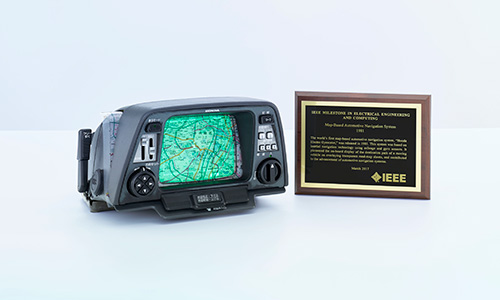Honda Electro Gyrocator Recognized as IEEE Milestone
March 2, 2017, Japan
TOKYO, Japan, March 2, 2017 - Honda Motor Co., Ltd. today announced that the Honda Electro Gyrocator, commercialized in 1981 as the world’s first*1 map-based automotive navigation system, has been honored as an IEEE Milestone.
A commemoration ceremony was held today at the global headquarters of Honda in Aoyama, Tokyo at 11:00 am and the milestone plaque was presented by IEEE President Karen Bartleson.
The U.S.-based IEEE, The Institute of Electrical and Electronics Engineers, is the world’s largest non-profit organization of technical professionals in the areas of electrical, electronics, information and communications. With over 420,000 members in more than 190 countries, IEEE is the trusted voice on a wide variety of areas ranging from aerospace systems, computers and telecommunications to biomedical engineering, electric power and consumer electronics. With the IEEE Milestones program, IEEE honors historic achievements of groundbreaking innovations in the areas of electrical, electronics, information and communications technologies, which are at least 25 years old and have made a significant contribution to the advancement of society and industry. Since the start of the program in 1983, IEEE has honored 174 milestones*2 in the world before February 2017.
Honda became the first*1 company in the auto industry to be honored by this program, which recognizes that the development of the Honda Electro Gyrocator triggered the global popularization of map-based automotive navigation systems and contributed to the establishment of a global standard for the navigation system.
<About the Honda Electro Gyrocator>
The Honda Electro Gyrocator, commercialized in 1981, was the world’s first map-based automotive navigation system. Honda adopted a direction sensor which was developed as a result of the world’s first*1 practical application of gas-rate gyro sensor for automobiles. The gas-rate gyro sensor detects the direction the vehicle is moving. The combination of this direction sensor, driving distance sensor, microcomputer and other technologies enabled it to detect direction and the distance of the movement, which were used to calculate the current position of the vehicle. By indicating the current location, direction and driving trajectory of the vehicle on a cathode-ray tube (CRT) display where the user placed the map film, it was made easier for the driver to select which path to take.
- *1Honda internal research
- *2Key IEEE Milestones recognized in the past
- Tokaido Shinkansen (Bullet Train) (2000, Central Japan Railway Company)
- Kurobe River No. 4 Hydropower Plant (2010, Kansai Electric Power Co., Inc.)
- Apollo Lunar Module (2011, Northrop Grumman Corporation)

Honda Electro Gyrocator (left) and IEEE Milestone Plaque (right)